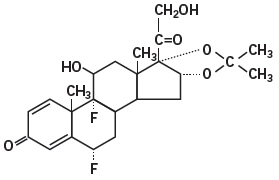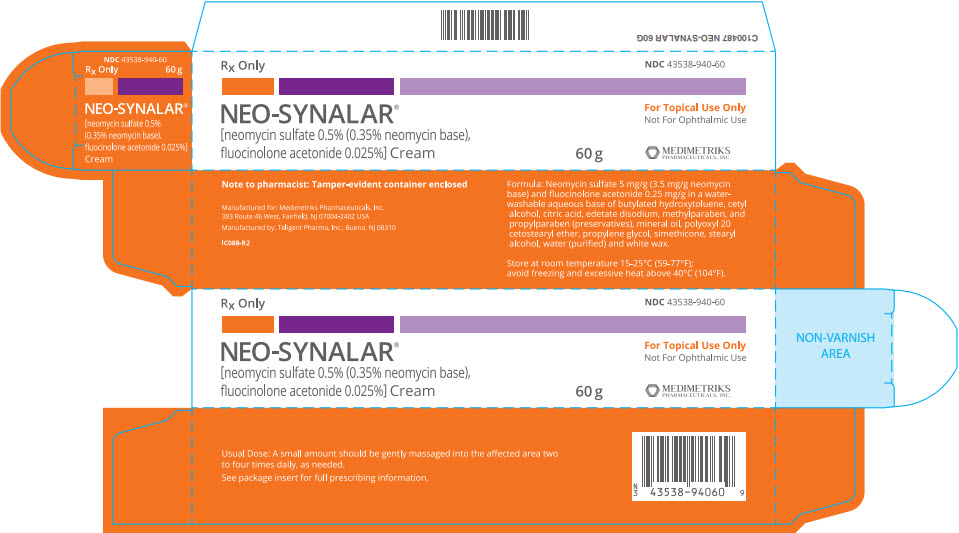NEO-SYNALAR- neomycin sulfate and fluocinolone acetonide cream
Neo-Synalar by
Drug Labeling and Warnings
Neo-Synalar by is a Prescription medication manufactured, distributed, or labeled by Medimetriks Pharmaceuticals, Teligent Pharma. Drug facts, warnings, and ingredients follow.
Drug Details [pdf]
- SPL UNCLASSIFIED SECTION
-
DESCRIPTION
NEO-SYNALAR® cream is intended for topical administration. The active component is the corticosteroid fluocinolone acetonide, which has the chemical name pregna-1,4-diene-3,20-dione,6,9-difluoro-11,21-dihydroxy-16,17-[(1-methylethylidene)bis (oxy)]-,(6α,11β,16α)-, and the antibacterial neomycin sulfate. Fluocinolone acetonide has the following chemical structure:

The cream contains neomycin sulfate 5 mg/g (3.5 mg/g neomycin base) and fluocinolone acetonide 0.25 mg/g in a water-washable aqueous base of butylated hydroxytoluene, cetyl alcohol, citric acid, edetate disodium, methylparaben and propylparaben (preservatives), mineral oil, polyoxyl 20 cetostearyl ether, propylene glycol, simethicone, stearyl alcohol, water (purified) and white wax.
-
CLINICAL PHARMACOLOGY
Topical corticosteroids share anti-inflammatory, anti-pruritic and vasoconstrictive actions.
The mechanism of anti-inflammatory activity of the topical corticosteroids is unclear. Various laboratory methods, including vasoconstrictor assays, are used to compare and predict potencies and/or clinical efficacies of the topical corticosteroids. There is some evidence to suggest that a recognizable correlation exists between vasoconstrictor potency and therapeutic efficacy in man.
Pharmacokinetics
The extent of percutaneous absorption of topical corticosteroids is determined by many factors including the vehicle, the integrity of the epidermal barrier, and the use of occlusive dressings.
Topical corticosteroids can be absorbed from normal intact skin. Inflammation and/or other disease processes in the skin increase percutaneous absorption. Occlusive dressings substantially increase the percutaneous absorption of topical corticosteroids.
Once absorbed through the skin, topical corticosteroids are handled through pharmacokinetic pathways similar to systemically administered corticosteroids. Corticosteroids are bound to plasma proteins in varying degrees. Corticosteroids are metabolized primarily in the liver and are then excreted by the kidneys. Some of the topical corticosteroids and their metabolites are also excreted into the bile.
-
INDICATIONS AND USAGE
NEO-SYNALAR® cream is indicated for the treatment of corticosteroid-responsive dermatoses with secondary infection. It has not been demonstrated that this steroid-antibiotic combination provides greater benefit than the steroid component alone after 7 days of treatment (see WARNINGS section).
- CONTRAINDICATIONS
-
WARNINGS
If local infection should continue or become severe, or in the presence of systemic infection, appropriate systemic antibacterial therapy, based on susceptibility testing, should be considered.
Because of the concern of nephrotoxicity and ototoxicity associated with neomycin, this combination product should not be used over a wide area or for extended periods of time.
There are articles in the current medical literature that indicate an increase in the prevalence of persons sensitive to neomycin.
-
PRECAUTIONS
General
It is recommended that NEO-SYNALAR® cream not be used under occlusive dressings. Systemic absorption of topical corticosteroids has produced reversible hypothalamic-pituitary-adrenal (HPA) axis suppression, manifestations of Cushing's syndrome, hyperglycemia, and glucosuria in some patients.
Conditions which augment systemic absorption include the application of the more potent steroids, use over large surface areas, prolonged use.
Therefore, patients receiving a large dose of a potent topical steroid applied to a large surface area should be evaluated periodically for evidence of HPA axis suppression by using the urinary free cortisol and ACTH stimulation tests. If HPA axis suppression is noted, an attempt should be made to withdraw the drug, to reduce the frequency of application, or to substitute a less potent steroid.
Recovery of HPA axis function is generally prompt and complete upon discontinuation of the drug. Infrequently, signs and symptoms of steroid withdrawal may occur, requiring supplemental systemic corticosteroids.
Children may absorb proportionally larger amounts of topical corticosteroids and thus be more susceptible to systemic toxicity (see PRECAUTIONS—Pediatric Use).
If irritation develops, topical corticosteroids should be discontinued and appropriate therapy instituted.
As with any topical corticosteroid product, prolonged use may produce atrophy of the skin and subcutaneous tissues. When used on intertriginous or flexor areas, or on the face, this may occur even with short-term use.
Information for the Patient
Patients using topical corticosteroids should receive the following information and instructions:
- This medication is to be used as directed by the physician. It is for external use only. Avoid contact with the eyes.
- Patients should be advised not to use this medication for any disorder other than that for which it was prescribed.
- The treated skin area should not be bandaged or otherwise covered or wrapped as to be occlusive unless directed by the physician.
- Patients should report any signs of local adverse reactions, especially under occlusive dressing.
- Parents of pediatric patients should be advised not to use tight-fitting diapers or plastic pants on a child being treated in the diaper area, as these garments may constitute occlusive dressings.
Laboratory Tests
The following tests may be helpful in evaluating the HPA axis suppression:
- Urinary free cortisol test
- ACTH stimulation test
Carcinogenesis, Mutagenesis, and Impairment of Fertility
Long-term animal studies have not been performed to evaluate the carcinogenic potential or the effect on fertility of topical corticosteroids.
Studies to determine mutagenicity with prednisolone and hydrocortisone have revealed negative results.
Pregnancy Category C
Corticosteroids are generally teratogenic in laboratory animals when administered systemically at relatively low dosage levels. The more potent corticosteroids have been shown to be teratogenic after dermal application in laboratory animals. There are no adequate and well-controlled studies in pregnant women on teratogenic effects from topically applied corticosteroids. Therefore, topical corticosteroids should be used during pregnancy only if the potential benefit justifies the potential risk to the fetus. Drugs of this class should not be used extensively on pregnant patients, in large amounts, or for prolonged periods of time.
Nursing Mothers
It is not known whether topical administration of corticosteroids could result in sufficient systemic absorption to produce detectable quantities in breast milk. Systemically administered corticosteroids are secreted into breast milk in quantities not likely to have a deleterious effect on the infant. Nevertheless, caution should be exercised when topical corticosteroids are administered to a nursing woman.
Pediatric Use
Pediatric patients may demonstrate greater susceptibility to topical corticosteroid-induced hypothalmic-pituitary-adrenal (HPA) axis suppression and Cushing's syndrome than mature patients because of a larger skin surface area to body weight ratio.
Hypothalmic-pituitary-adrenal (HPA) axis suppression, Cushing's syndrome, and intracranial hypertension have been reported in children receiving topical corticosteroids. Manifestations of adrenal suppression in children include linear growth retardation, delayed weight gain, low plasma cortisol levels, and absence of response to ACTH stimulation. Manifestations of intracranial hypertension include bulging fontanelles, headaches, and bilateral papilledema.
Administration of topical corticosteroids to children should be limited to the least amount compatible with an effective therapeutic regimen. Chronic corticosteroid therapy may interfere with the growth and development of children.
-
ADVERSE REACTIONS
The following local adverse reactions are reported infrequently with topical corticosteroids. These reactions are listed in an approximate decreasing order of occurrence:
Burning Hypertrichosis Maceration of the skin Itching Acneiform eruptions Secondary infection Irritation Hypopigmentation Skin atrophy Dryness Perioral dermatitis Striae Folliculitis Allergic contact dermatitis Miliaria The following adverse reactions have been reported with the topical use of neomycin:
Ototoxicity Nephrotoxicity -
OVERDOSAGE
Topically applied corticosteroids can be absorbed in sufficient amounts to produce systemic effects (see PRECAUTIONS).
- DOSAGE AND ADMINISTRATION
-
HOW SUPPLIED
NEO-SYNALAR® [neomycin sulfate 0.5% (0.35% neomycin base), fluocinolone acetonide 0.025%] Cream is supplied in
- 15 g Tube – NDC: 43538-940-15
- 60 g Tube – NDC: 43538-940-60
- SPL UNCLASSIFIED SECTION
- PRINCIPAL DISPLAY PANEL - 60 g Tube Carton
-
INGREDIENTS AND APPEARANCE
NEO-SYNALAR
neomycin sulfate and fluocinolone acetonide creamProduct Information Product Type HUMAN PRESCRIPTION DRUG Item Code (Source) NDC: 43538-940 Route of Administration TOPICAL Active Ingredient/Active Moiety Ingredient Name Basis of Strength Strength neomycin sulfate (UNII: 057Y626693) (neomycin - UNII:I16QD7X297) neomycin 3.5 mg in 1 g fluocinolone acetonide (UNII: 0CD5FD6S2M) (fluocinolone acetonide - UNII:0CD5FD6S2M) fluocinolone acetonide 0.25 mg in 1 g Inactive Ingredients Ingredient Name Strength butylated hydroxytoluene (UNII: 1P9D0Z171K) cetyl alcohol (UNII: 936JST6JCN) citric acid monohydrate (UNII: 2968PHW8QP) edetate disodium (UNII: 7FLD91C86K) propylparaben (UNII: Z8IX2SC1OH) methylparaben (UNII: A2I8C7HI9T) mineral oil (UNII: T5L8T28FGP) polyoxyl 20 cetostearyl ether (UNII: YRC528SWUY) propylene glycol (UNII: 6DC9Q167V3) stearyl alcohol (UNII: 2KR89I4H1Y) water (UNII: 059QF0KO0R) white wax (UNII: 7G1J5DA97F) Product Characteristics Color WHITE Score Shape Size Flavor Imprint Code Contains Packaging # Item Code Package Description Marketing Start Date Marketing End Date 1 NDC: 43538-940-60 1 in 1 CARTON 06/11/1963 1 60 g in 1 TUBE; Type 0: Not a Combination Product 2 NDC: 43538-940-99 4 in 1 CARTON 06/11/1963 2 3 g in 1 TUBE; Type 0: Not a Combination Product Marketing Information Marketing Category Application Number or Monograph Citation Marketing Start Date Marketing End Date ANDA ANDA060700 06/11/1963 Labeler - Medimetriks Pharmaceuticals (019903816) Establishment Name Address ID/FEI Business Operations Teligent Pharma 011036910 MANUFACTURE(43538-940)
Trademark Results [Neo-Synalar]
Mark Image Registration | Serial | Company Trademark Application Date |
|---|---|
 NEO-SYNALAR 85740054 4649655 Live/Registered |
Medimetriks Pharmaceuticals, Inc. 2012-09-27 |
 NEO-SYNALAR 73254474 1171932 Dead/Cancelled |
Syntex (U.S.A.) Inc. 1980-03-17 |
© 2025 FDA.report
This site is not affiliated with or endorsed by the FDA.
